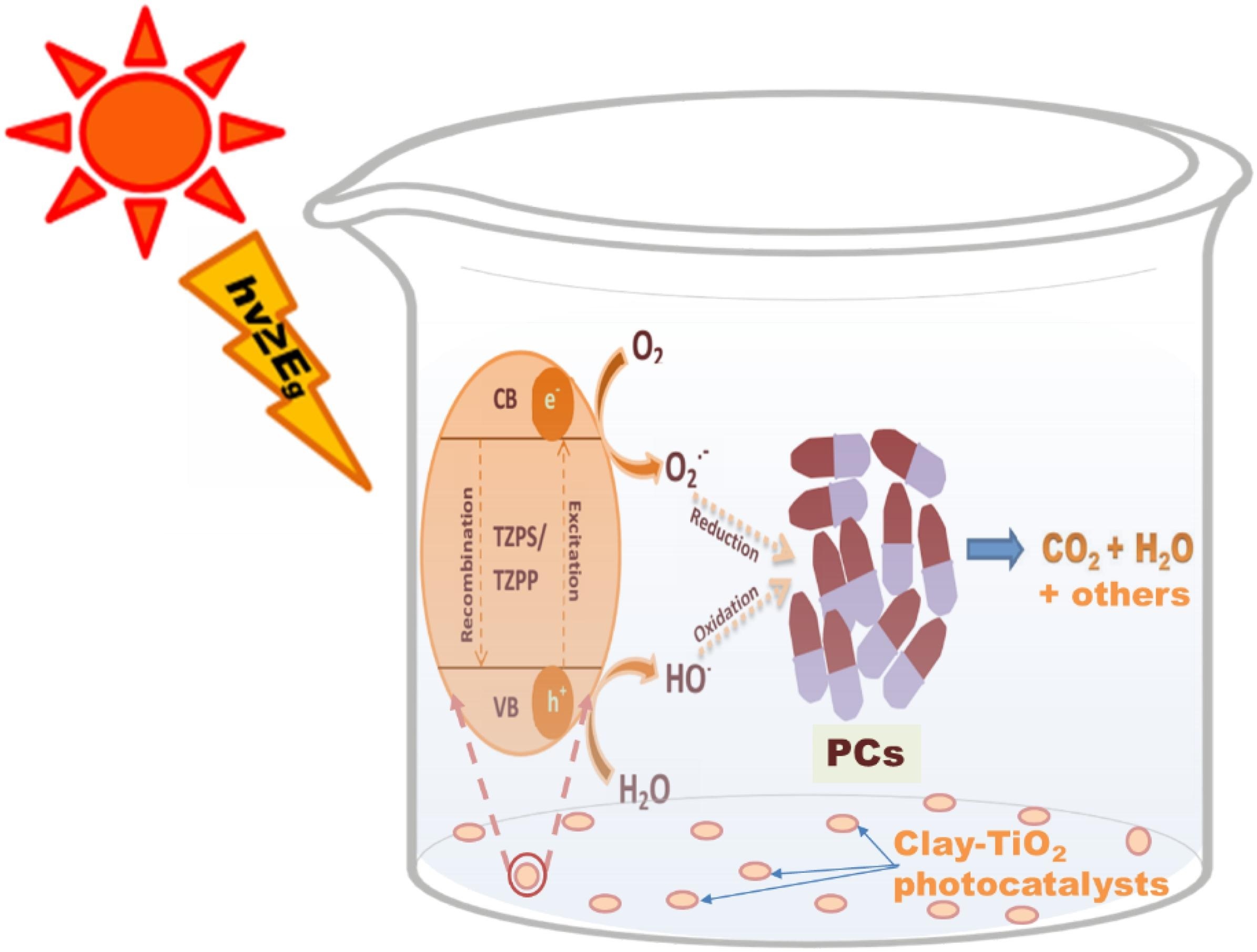Solar-active clay-TiO2 nanocomposites prepared via biomass assisted synthesis: efficient removal of ampicillin, sulfamethoxazole and artemether from water.
ALFRED, Moses O.; OMOROGIE, Martins O.; BODEDE, Olusola; MOODLEY, Roshila; OGUNLAJA, Aemere; ADEYEMI, Olalere G.; GÜNTER, Christina; TAUBERT, Andreas; IERMAK, Ievgeniia; ECKERT, Hellmut; SILVA, Igor Danciães Almeida; DE CAMARGO, Andrea Simone Stucchi; MOTHEO, Artur de Jesus; CLARKE, Stuart M.; UNUABONAHA, Emmanuel I.
ALFRED, Moses O.; OMOROGIE, Martins O.; BODEDE, Olusola; MOODLEY, Roshila; OGUNLAJA, Aemere; ADEYEMI, Olalere G.; GÜNTER, Christina; TAUBERT, Andreas; IERMAK, Ievgeniia; ECKERT, Hellmut; SILVA, Igor Danciães Almeida; DE CAMARGO, Andrea Simone Stucchi; MOTHEO, Artur de Jesus; CLARKE, Stuart M.; UNUABONAHA, Emmanuel I.




 Abstract: New solar-active nanocomposites free from toxic reagents or precious metals were developed. They were prepared from natural kaolinite clay, Na2WO4, titania, and biomass. The photocatalytic activity of the nanocomposites against two antibiotics [Ampicillin (AMP) and Sulfamethoxazole (SMX)] and an antimalarial drug [Artemether (ART)] under sunlight suggests an unusually fast photodegradation that is >90% complete in 30 min especially with the photocatalytic nanocomposite prepared from Musa paradisiaca peels (plantain peels) @ 500 °C (TZPP5). The presence of both biomass and TiO2 is essential for the effective function of the photocatalytic nanocomposites. With TZPP5, ca. 80% and ca. 50% mineralisation of AMP and SMX, respectively, was observed after 60 min. The photocatalytic reaction releases inorganic by-products (SO42-, NO3- and NH4+) at levels below WHO permissible limits for drinking water. The presence of anions reduces the efficiency of TZPP5, indicating that it releases electrons and reactive oxygen species that are also responsible for photodegradation of the drugs. However, changing concentrations of electrolyte (NaCl) do not influence its efficiency, suggesting that adsorption may not precede photocatalysis, contrary to common models. Reuse studies suggest a slight loss in photodegradation efficiency (?6%) of the nanocomposite for AMP in the first two cycles followed by subsequent stability at 70% for subsequent cycles. This is different for SMX, which maintained ?58% removal for all cycles after the 1st cycle. With efficient treatment of raw wastewater from an abattoir, a river, and a hand-dug well for drinking water, the photocatalytic nanocomposite shows potential for treating drinking water especially in point-of-use water treatment devices.
Abstract: New solar-active nanocomposites free from toxic reagents or precious metals were developed. They were prepared from natural kaolinite clay, Na2WO4, titania, and biomass. The photocatalytic activity of the nanocomposites against two antibiotics [Ampicillin (AMP) and Sulfamethoxazole (SMX)] and an antimalarial drug [Artemether (ART)] under sunlight suggests an unusually fast photodegradation that is >90% complete in 30 min especially with the photocatalytic nanocomposite prepared from Musa paradisiaca peels (plantain peels) @ 500 °C (TZPP5). The presence of both biomass and TiO2 is essential for the effective function of the photocatalytic nanocomposites. With TZPP5, ca. 80% and ca. 50% mineralisation of AMP and SMX, respectively, was observed after 60 min. The photocatalytic reaction releases inorganic by-products (SO42-, NO3- and NH4+) at levels below WHO permissible limits for drinking water. The presence of anions reduces the efficiency of TZPP5, indicating that it releases electrons and reactive oxygen species that are also responsible for photodegradation of the drugs. However, changing concentrations of electrolyte (NaCl) do not influence its efficiency, suggesting that adsorption may not precede photocatalysis, contrary to common models. Reuse studies suggest a slight loss in photodegradation efficiency (?6%) of the nanocomposite for AMP in the first two cycles followed by subsequent stability at 70% for subsequent cycles. This is different for SMX, which maintained ?58% removal for all cycles after the 1st cycle. With efficient treatment of raw wastewater from an abattoir, a river, and a hand-dug well for drinking water, the photocatalytic nanocomposite shows potential for treating drinking water especially in point-of-use water treatment devices. @article={002999829,author = {ALFRED, Moses O.; OMOROGIE, Martins O.; BODEDE, Olusola; MOODLEY, Roshila; OGUNLAJA, Aemere; ADEYEMI, Olalere G.; GÜNTER, Christina; TAUBERT, Andreas; IERMAK, Ievgeniia; ECKERT, Hellmut; SILVA, Igor Danciães Almeida; DE CAMARGO, Andrea Simone Stucchi; MOTHEO, Artur de Jesus; CLARKE, Stuart M.; UNUABONAHA, Emmanuel I.},title={Solar-active clay-TiO2 nanocomposites prepared via biomass assisted synthesis: efficient removal of ampicillin, sulfamethoxazole and artemether from water},journal={Chemical Engineering Journal},note={v. 398, p. 125544-1-125544-14 + supplementary data: 1-29},year={2020}}
@article={002999829,author = {ALFRED, Moses O.; OMOROGIE, Martins O.; BODEDE, Olusola; MOODLEY, Roshila; OGUNLAJA, Aemere; ADEYEMI, Olalere G.; GÜNTER, Christina; TAUBERT, Andreas; IERMAK, Ievgeniia; ECKERT, Hellmut; SILVA, Igor Danciães Almeida; DE CAMARGO, Andrea Simone Stucchi; MOTHEO, Artur de Jesus; CLARKE, Stuart M.; UNUABONAHA, Emmanuel I.},title={Solar-active clay-TiO2 nanocomposites prepared via biomass assisted synthesis: efficient removal of ampicillin, sulfamethoxazole and artemether from water},journal={Chemical Engineering Journal},note={v. 398, p. 125544-1-125544-14 + supplementary data: 1-29},year={2020}}